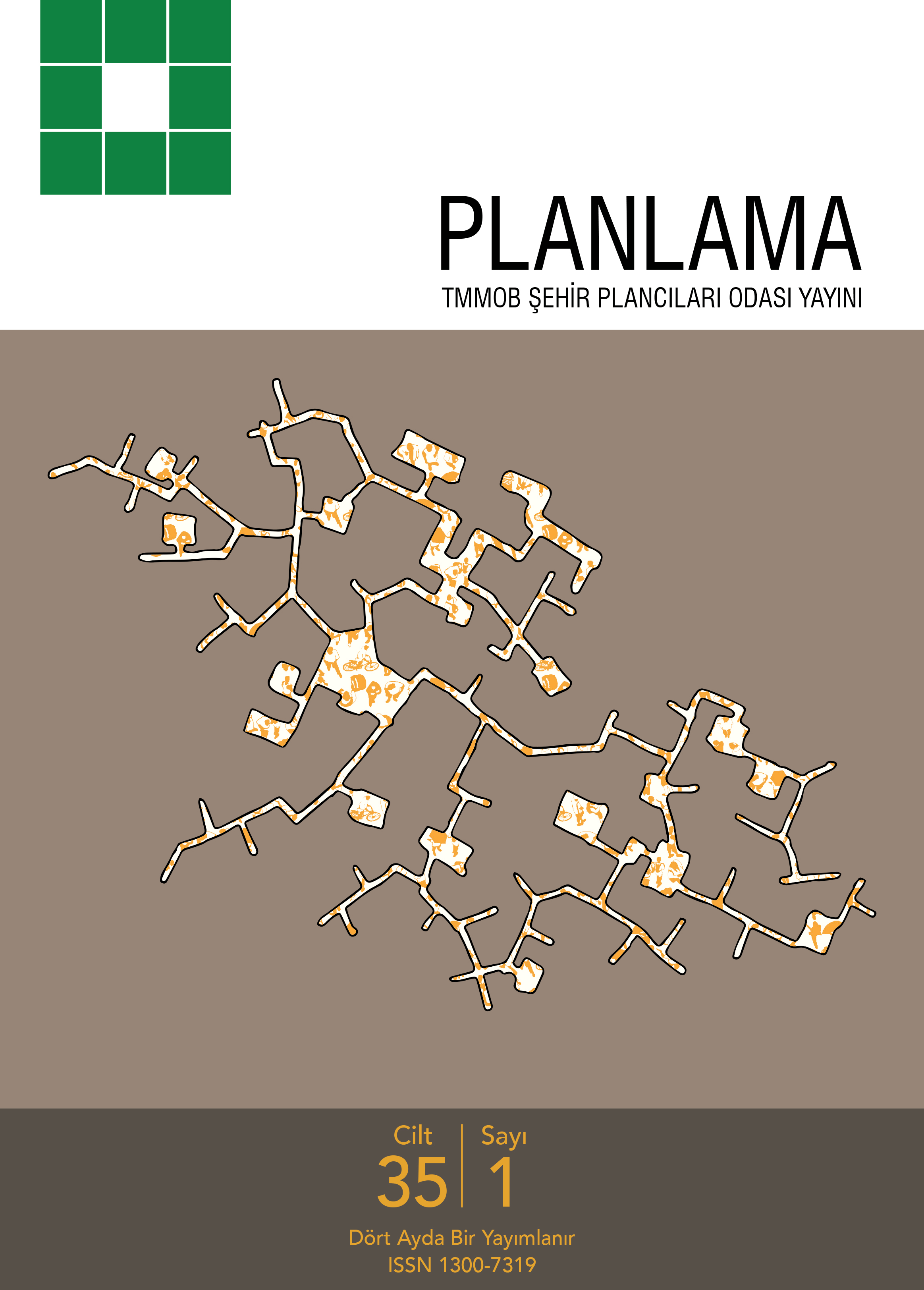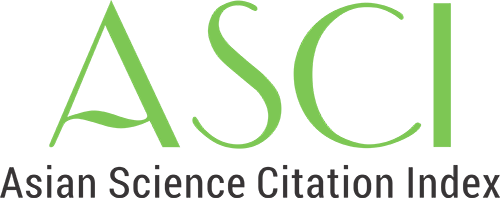Volume: 35 Issue: 1 - 2025
| EDITORIAL | |
| 1. | Editorial Page X |
| RESEARCH ARTICLE | |
| 2. | Chronic Stresses in Resilient Urban Planning: Examining the Population-Amenity Balance Issue in Land Use Through the Case of Istanbul-Bağcılar Yunus Tatar, İclal Sema Dinçer doi: 10.14744/planlama.2024.03880 Pages 1 - 21 Cities can only be passed on to future generations if they are resilient to disasters. A critical factor influencing urban resilience is land use decisions. The size, density, and distribution of residential, commercial, and industrial areas, as well as the adequacy of green spaces and infrastructure, play a significant role in shaping resilience and quality of life. This article focuses on the Bağcılar district of Istanbul, analyzing whether urban resilience is achievable in densely populated areas with inadequate resources. Based on findings from the analysis, chronic stresses hindering urban resilience were identified, and recommendations were developed to address these challenges. As part of the field study, current land use patterns, transportation infrastructure, and the distribution of disaster assembly areas were examined. The aim was to evaluate the adequacy of existing amenities within land use plans in relation to population density. A detailed land use analysis was conducted at the neighborhood level to assess the capacity of existing facilities and infrastructure. Scenarios addressing the population-amenity balance were tested. Additionally, the adequacy of disaster assembly areas was analyzed, considering their spatial dimensions and compliance with standard criteria. Bağcılar's spatial planning history was reviewed using archival research and GIS mapping. Zoning plan amendments between 1986 and 2014 were analyzed manually, while post-2014 changes were examined via the e-plan automation system. These findings allowed inferences to be made regarding population density, land use changes, and mechanisms tied to the spatial planning culture. Proposed solutions are grounded in the legal framework of Article 18 of the Zoning Law No. 3194 (Land Readjustment Contribution Share). The study emphasizes "Chronic Stresses Preventing Urban Resilience" and aims to clarify factors impeding resilience. Furthermore, it tests urban resilience under existing and hypothetical scenarios, providing scientific contributions for future research. |
| 3. | A Comparative Study on the Technopark Ecosystems for Region-Specific Approaches: The Case of Erciyes and Mersin Burcu Müderrisoğlu Karamichos, Ferhan Gezici, Güliz Öztürk doi: 10.14744/planlama.2024.82956 Pages 22 - 34 Technoparks are seen as a means of strengthening the dynamics of the local/regional economy by attracting high-tech firms. However, studies focusing on technoparks in relation to the regional innovation systems are limited. The paper aims to explore technopark ecosystems, the role of universities, technopark management and regional actors, cooperation potentials and innovation processes, taking into account the specificity of the region in which it is located. The research was conducted in two city-regions taking into account the studies concentrated in Turkey's most developed metropolitan cities, and aimed to contribute to the gap in this field. For the purpose of the research, the interviews with relevant actors and the results of the workshop held in the next stage were combined with secondary data regarding city-regions. The results of this research support that technoparks as a policy tool for both innovation and regional development, cannot be proposed as a one-size fits all model. The case of Erciyes Technopark provided advantages through Kayseri's focus on production and export, its efforts to achieve structural transformation in the industry, strong social networks, entrepreneurial culture and loyalty to the city, the strong effect on the cities in its vicinity, and the power of political relations. Although Mersin Technopark is located in an important port city, its success is inhibited by the limited strength of the city's industrial infrastructure, and limited human capital capacity regarding the high immigration. |
| 4. | Discussing Urban Space in the Shadow of the 2024 Local Election Promises İpek Sakarya doi: 10.14744/planlama.2024.13334 Pages 35 - 49 This study critically analyzes the local election manifestos issued by political parties in the lead-up to Turkey's 2024 local elections, focusing on their approaches to urban space. These manifestos are not only key political documents but also reflect the parties' strategies and policy proposals for the future development of local areas. They highlight plans for urban spaces while often critiquing the urban policies of ruling parties, especially at the local level. The outcomes of the 2024 elections marked a pivotal moment in Turkish politics, shaped by the transformation of urban spaces over the past two decades and the dynamics of the electoral process. Accordingly, this study examines both the spatial transformations Turkey has experienced over the past two decades and the role of local politics within the broader framework of Turkish politics. The study focuses on the manifestos of the winning parties at the metropolitan, provincial, and district levels, examining their proposals on urban issues such as urban rent, urban transformation, spatial planning, and visions for future cities. By doing so, it aims to shed light on the relationship between the local political agenda and urban spatial development in contemporary Turkey. |
| 5. | Climate Compatible Planning Approach in Rural-Urban Fringe: The Case of Denizli Gamze Aşıcı, Aysun Aygün Oğur, Dalya Hazar doi: 10.14744/planlama.2024.10438 Pages 50 - 69 Urban and rural areas are highly vulnerable to the effects of climate change and are adversely impacted by the natural disasters it causes. Given their fragile structure and current impacts, enhancing social and spatial resilience has become crucial in the process of combating climate change. To address this, there is a need for methods and strategies that guide local actions and take a holistic approach to both urban and rural areas. This study aims to examine urban and rural areas from a comprehensive perspective in the context of combating climate change and to highlight the significance of the rural-urban fringe, an important transitional zone, in this process. Specifically, the research seeks to answer the following questions: "What are the vulnerabilities and potentials of the rural-urban fringe in the fight against climate change?" and "How can the rural-urban fringe be planned to adapt to climate change?" Denizli rural-urban fringe serves as a case study to explore these questions. The study first established criteria for evaluating adaptation and risk factors related to climate change. A field study was then conducted in a sub-region selected from the periphery of Denizli, based on the city's development trends and the established criteria. Through spatial observations and in-depth interviews, the socio-spatial characteristics, development trends, and future projections of the study area were identified, with its problems and potentials analyzed. Based on this analysis, adaptive planning strategies were proposed. Ultimately, the study presents a framework for planning climate-resilient and sustainable rural-urban environments and offers a climate-responsive planning approach/guideline for medium-sized cities such as Denizli. |
| 6. | Ethical Codes in Urban Planning: A Comparative Analysis of Professional Standards and Ethical Values Cihan Mert Sabah, Aliye Ahu Gülümser doi: 10.14744/planlama.2024.74875 Pages 70 - 86 This article emphasizes the importance and complexity of ethical codes in the discipline of urban planning. Ethical challenges encountered in urban planning processes exhibit diversity at both national and global levels. The study analyzes universal and local values embedded in ethical codes shaped by different national and cultural contexts. It highlights the necessity for planners to communicate these values clearly and comprehensively, thereby ensuring consistent ethical decision-making and societal acceptance. In light of this information, the aim of this article is to review and evaluate how ethical issues are addressed within the planning discipline and how planners fulfill their ethical responsi-bilities. Furthermore, it conducts three classifications based on the content analysis of ethical principles and codes of conduct prepared by various planning institutions, examining their language, audience, and professional ethical definitions and expressions related to sustainability. Ultimately, the existence of ethical codes emerging from discussions on professional ethics in urban planning underscores their significance for the validity of planning as a profession. Additionally, it identifies that the dynamics of ethical values in the planning discipline vary according to universal and local characteristics. Analysis of the practical applicability and effectiveness of ethical codes provides an important framework for future research. It emphasizes the need for future studies to focus on the practical applicability and effectiveness of ethical codes, thereby contributing to the development of more ethical and sustainable cities in urban planning. |
| 7. | Does the Affordability of Housing Always Guarantee Access to an Ideal Home? Almira Yılmaz Çetinkaya, Bora Yerliyurt doi: 10.14744/planlama.2024.48742 Pages 87 - 106 This study argues that addressing the housing problem in Turkey and globally solely in financial terms is insufficient. While affordability is important, factors like housing condition, security, and the environment also impact quality of life. Households' needs and living standards are shaped by both financial resources and their social and physical surroundings. Therefore, to ensure the sustainability of housing rights, both the condition of the housing and the demands of the household must be considered. After 2019, the housing problem worsened globally due to the social and economic impacts of the pandemic. As purchasing power declined in Turkey and worldwide, housing prices for rent and sale soared, driven by high inflation. While housing research has largely focused on affordability, it often overlooks the condition of the homes people live in. This gap highlights the need for a more comprehensive approach to problem, one that considers both affordability and the quality and suitability of the housing itself. This study examines housing problems related to household behavior and housing conditions, even when house is affordable. By examining parameters such as socio-economic-statues, integrated earthquake risk, neighborhood average-rent-prices; through all analysis for Istanbul we found that the Büyükçekmece, Hürriyet Neighborhood had the lowest housing affordability but also the highest integrated earth-quake risk; surveys conducted with homeowners and tenants. Research identified issues such as inadequate personal space, high transportation costs and living in earthquake-risk housing. As a result, we found that, apart from affordability, there is a problem of housing accessibility requested by the household. |
| 8. | Using Social Media Data to Define Boundaries of City Centers: The Case of İzmit By Foursquare Tayfun Salihoğlu, Sena Barış Daşdemir doi: 10.14744/planlama.2025.78790 Pages 107 - 125 Social media has significant potential as a data source for spatial studies. The aim of this study is to determine the boundaries of the central area of Kocaeli using location-based social media data and to assess the accuracy of the method by comparing it with the central point in the existing zoning plan. In this context, the concept of city center has been emphasized and theories related to city centers have been explained. Additionally, concepts related to social media, which has recently started to be used as a data source in planning, have been explained, and examples of spatial studies conducted using this data have been presented. The district of Izmit in Kocaeli has been chosen as the study area. For the study, location-based point data was obtained using the Foursquare API. Based on literature research conducted within the Foursquare developer community, uses that are densely located in the centers have been identified, and these categories of spaces have been selected for practical application. Geographic location data belonging to these categories has been mapped, and density analyses have been conducted using GIS tools. Subsequently, spatial analyses have been overlaid and examined holistically. By superimposing the generated density maps, the boundaries of the city center have been determined. To demonstrate the representational capability of social media data in defining the central boundaries, the relationship between Foursquare data and the central point in the Izmit zoning plans has been examined through mapping and correlation analysis. |
| 9. | Exploring the Contemporary Dynamics of Extended Urbanisation: A Comprehensive Analysis on the Case of Denizli, Turkey Büşra Kolaoğlu, Mehmet Penpecioglu, Aysun Aygün Oğur doi: 10.14744/planlama.2025.10692 Pages 126 - 154 Contemporary discussions about extended urbanization and its inherent practices of suburbanization particularly focus on metropolitan cities in the Global South. There is inadequate empirical evidence on the rapidly developing Anatolian cities in Turkey. To address this gap, this article analyzes Denizlis extended urban development process, elaborates on the dominant practices, and examines the driving forces shaping its rapid, contested, and fragmented socio-spatial landscape. As one of the most ubiquitous cases among rapidly developing Anatolian cities, Denizli highlights the leading role of fragmented urban development planning interventions, the stimulating impact of transportation and infrastructure investments, and the pivotal role of private sector projects. The research consists of urban spatial analysis using statistical data and urban planning documents, detecting land use/cover changes over time, and identifying the driving factors that have influenced and shaped the patterns of urban development in Denizli. The findings indicate that fragmented urban development planning interventions have both triggered and sustained extended urban development in Merkezefendi, Denizli. Moreover, key public investments and real estate projects have fostered this extended urban development process, leading to disjointed fragments in a socio-economically polarized geography. As a diversified and relational formation of extended urbanization, Denizli provides genuine research findings, and includes remarkable similarities as well as differences in the comparative analysis of global urbanism practices. |
| 10. | Determination of Expected Benefits from Urban Transformation Projects Using AHP-BWM Method Tuna Batuhan, Ali Muti, Çağlar Kıvanç Kaymaz, Musa Yilmaz doi: 10.14744/planlama.2025.57983 Pages 155 - 170 In this study, a model consisting of structural (S), environmental (E) and socio-cultural (S) main dimensions and their sub-criteria has been proposed to assist in multi-criteria selection and ranking decisions of the benefits expected from urban transformation projects. The importance levels of the 3 dimensions and 17 sub-criteria in this model were evaluated and analyzed using the Analytical Hierarchy Process (AHP) and Best-Worst Model (BWM), which are among the MCDM methods. According to the results based on the opinions of 13 experts, structural features are the most important dimension in both AHP and BWM methods, followed by environmental features and socio-cultural features. The most important crateria is "taking disaster risks into account" for AHP method and "the design and landscaping of open spaces" for BWM method. The findings of the study make a significant contribution to the literature by defining 3 dimensions and 17 sub-criteria to be used to determine the benefits expected from urban transformation projects and by determining the importance weights for each dimension and criterion with two different methods. It is clear that more explanatory studies are needed to expand the general framework established in this study. In this study, the basic dimensions and criteria and their weights are based on expert opinions presented in the Turkish context. The benefits expected from urban transformation projects have different priorities for each country/city, it would be useful to conduct new studies in the context of countries and cities using expert groups from other countries to provide different perspectives. |
| REVIEW | |
| 11. | Who Moves to the Countryside, and Why? A Systematic Review of Urban-to-rural Migration Rüya Erkan-Öcek, Tolga İslam doi: 10.14744/planlama.2024.00086 Pages 171 - 181 As urban areas face issues such as overcrowding and high living costs, rural destinations are attracting diverse migrant groups seeking alternative lifestyles and improved quality of life. This study aims to provide a comprehensive overview of who these migrants are and what drives their decisions to re-locate. Following PRISMA guidelines, we analysed 337 peer-reviewed articles from Scopus and Web of Science databases up to 2024. Our findings reveal that urban-to-rural migrants are a heterogeneous group spanning various ages, educational backgrounds, and socioeconomic statuses. Motivations for migration are multifaceted, encompassing economic factors like lower living costs and entrepreneurial opportunities, as well as non-economic drivers such as community connection and proximity to nature. The COVID-19 pandemic has further influenced these trends, accelerating remote work possibilities and health-related concerns. This review highlights the complexity of urban-to-rural migration, emphasizing its potential impacts on rural community dynamics, economic development, and policy-making. |
| OPINION LETTER | |
| 12. | Urban Transformation as an Imagination on Social Mass, the Case of Avcılar District Ayşegül Laçin doi: 10.14744/planlama.2024.69376 Pages 182 - 186 Abstract | |













